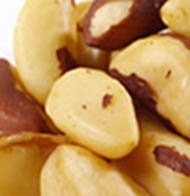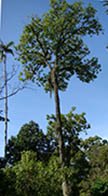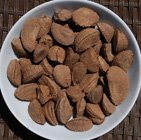Brazil nuts Nutrition facts
Amazon's dense forest holds some of the unique plant species like Brazil nuts, açaí berry., guarana, that can be found nowhere else on the planet Earth. Botanically, the brazil-nut tree belongs to the family of Lecythidaceae, in the genus: Bertholletia. Scientific name: Bertholletia excelsa.
Native Amazonians cherished these delicious nuts for ages, which provided them much-needed protein, fats, and other essential nutrients. Some of the common names in local dialects are castanha-do-pará, castania, para-nut, cream-nut, Castaña-de-Brazil (chestnuts of Brazil), etc.
 |
 |
| Brazil nuts (cream nuts). Note their creamy butter appearance due to their high-fat content. | Castania tree (Bertholletia excelsa). Note for an acai palm on the background. Photo courtesy: mauroguanandi |
Brazil nut trees are conspicuous in the non-flooded forests of Brazil, Bolivia, and Peru. They indeed are one of the tallest and long-living plant species among all the tropical rainforest flora. It grows up to 50 meters in height with a large erect stem and wide umbrella-like foliage canopy near its top 1/3. Its lifespan is about 500 to 700 years. In a season, a mature tree produces up to 300 fruit pods.
A brazil nut pod features a thick outer shell, as in coconut, and may weigh up to 2.5 kg in weight. It takes about 14 months for the fruit to mature after pollination. Mature pods are falling to the ground, usually with a heavy sound. It may remain intact even after falling from such a height!
In their natural habitat, brazil nut pods are exclusively dependent upon caviomorph rodents. Agoutis (Dasyprocta spp.) have the ability to gnaw open its woody shell to free and disperse leftover seeds for germination.
Inside, each fruit pod features 10-25 seeds (kernels) arranged in segments. Each kernel, in turn, is encased in its thick dark-brown, thin shell. An edible white meat kernel features a triangular base with sloping sides. They have a sweet and nutty flavor. A nut weighs about 5 g.
Health benefits of Brazil nuts
Brazil nuts are high in calories and contain good quantities of vitamins, antioxidants, and minerals. In fact, they are one of the major, high-calorie food sources of native Amazonians to date!
100 g of brazil nuts provide about 656 calories. Their high caloric content chiefly comes from their fats. However, much of this fat content is monounsaturated fatty acids (MUFA) like palmitoleic acid (16:1) and oleic acid (18:1) that help lower LDL or "bad cholesterol" and increase HDL or "good cholesterol" levels in the blood.
Research studies suggest that the Mediterranean diet that is rich in monounsaturated fatty acids has been found to protect from coronary artery disease and strokes by favoring a healthy blood lipid profile.
The nuts are also a great source of vitamin-E; contain about 7.87 mg per 100 g (about 52% of RDA). Vitamin E is a powerful lipid-soluble antioxidant. It is required to maintain the integrity of mucosa and skin by protecting it from harmful oxygen-free radicals.
Brazil nuts hold exceptionally high levels of selenium. 100 g nuts provide about 1,917 µg, or 3485% of the recommended daily intake of selenium, rating them as the highest natural source of this mineral.
Selenium is an essential cofactor for the antioxidant enzyme, glutathione peroxidase. Just 1-2 nuts a day provide enough of this trace element. Adequate selenium in the diet can help prevent coronary artery disease, liver cirrhosis, and cancers.
Furthermore, just as in almonds and pine nuts, brazil nuts are also free from gluten protein. For the same reason, they are one of the popular ingredients in the preparation of gluten-free food formulas. These formula preparations, in fact, are healthy alternatives in people with a wheat food allergy, and celiac disease.
Additionally, these creamy nuts are an excellent source of the B-complex group of vitamins such as thiamin (51% of RDA per 100 g), riboflavin, niacin, pantothenic acid, vitamin B-6 (pyridoxine), and folates. Altogether, these vitamins work as co-factors for enzymes during cellular substrate metabolism inside the body.
In addition to selenium, they hold superb levels of other minerals such as copper, magnesium, manganese, potassium, calcium, iron, phosphorus, and zinc. Copper helps prevent anemia and bone weakness (osteoporosis). Manganese is an all-important co-factor for the antioxidant enzyme, superoxide dismutase.
Brazil nut oil, extracted from these nuts, has many traditional medicinal applications as an emollient and massage oil. It has a clear yellow color with a pleasant sweet smell and taste. Its emollient property helps keep skin well protected from dryness. It is also employed in cooking, and as a “carrier or base oil” in traditional medicines in aromatherapy, in the pharmaceutical and cosmetic industry.
| Principle | Nutrient Value | Percent of RDA |
|---|---|---|
| Energy | 659 Kcal | 33% |
| Carbohydrates | 11.74 g | 9% |
| Protein | 14.32 g | 26% |
| Total Fat | 67.10 g | 221% |
| Cholesterol | 0 mg | 0% |
| Dietary Fiber | 7.5 g | 20% |
| Vitamins | ||
| Folates | 22 μg | 5.5% |
| Niacin | 0.295 mg | 2% |
| Pantothenic acid | 0.184 mg | 3.5% |
| Pyridoxine | 0.101 mg | 8% |
| Riboflavin | 0.035 mg | 3% |
| Thiamin | 0.617 mg | 51% |
| Vitamin A | 0 IU | 0% |
| Vitamin C | 0.7 μg | 1% |
| Vitamin E-γ | 7.87 mg | 52% |
| Electrolytes | ||
| Sodium | 2 mg | 0% |
| Potassium | 597 mg | 13% |
| Minerals | ||
| Calcium | 160 mg | 16% |
| Copper | 1.743 mg | 194% |
| Iron | 2.43 mg | 30% |
| Magnesium | 376 mg | 94% |
| Manganese | 1.223 mg | 53% |
| Phosphorus | 725 mg | 103% |
| Selenium | 1917 mcg | 3485% |
| Zinc | 4.06 mg | 36% |
| Phyto-nutrients | ||
| Carotene-ß | 0 mcg | -- |
| Crypto-xanthin-ß | 0 μg | -- |
| Lutein-zeaxanthin | 0 μg | -- |
Selection and storage

|
| Unshelled brazil nuts. Note for dark brown color shell enclosing cream color edible kernel inside. photo: nickton |
Brazil nuts can be available raw (unshelled or shelled), roasted, and salted in the stores. Since the nuts are high in polyunsaturated fats, they may turn rancid and deteriorate rather early if exposed to air, humidity, and sunlight for prolonged periods. It is, therefore, recommended to purchase unshelled nuts and shell them as and when required to enjoy their meaty kernel.
Buy whole, brown-colored nuts that feature full, compact, and heavy in hand. Avoid shriveled and damaged ones as they may be affected by fungal mold.
Unshelled brazil nuts keep well in a cool, dry place for a few months. For extended use, store them in air-seal bags and place them in the refrigerator. This method will prevent them from turning rancid.
Culinary uses
Raw nuts are cut open from processing units using larger sheller (cracker) machines. For domestic purposes, small-size nutcracker machines or handheld pliers are sufficient.
Here are some serving tips:
Brazil nuts can be eaten all alone. Additionally, they can also be enjoyed roasted, salted, or sweetened.
They are also employed in fudge, puddings, pesto, chocolate bar, and crunchy bar preparations.
Coarsely ground Brazil nuts sprinkled over fruit/vegetable salads.
They are also used in desserts, particularly in fruitcakes.
Add them to the soup as well as meat and vegetable dishes.
Brazil nut oil used in salad dressing and cooking.
Safety profile
Brazil nut allergy, like other tree-nut allergies, may occur in some sensitive individuals. The reaction symptoms may range from simple skin itching (hives) to severe forms of anaphylactic manifestations, including breathing difficulty, pain abdomen, vomiting, and diarrhea. Cross-reactions may occur to some other nuts and fruits, especially of Anacardiaceae family such as mango, cashew nuts, pistachio, etc. Persons with known allergic reactions to any of these nuts may, therefore, need to observe caution.
Excess consumption of these nuts may result in selenium toxicity. Often, the symptoms may be severe, including nausea, vomiting, a garlicky smell in the breath, and emotional disturbances. Other likely manifestations may include dental caries, alopecia (loss of hair), neuropathic pain, and dermatitis. It is, therefore, advised to eat only a few nuts (2-4 nuts) per day (each nut weighs about 5 g). (Medical disclaimer).
≻≻-Back to Nuts and seeds from Brazil nuts. Visit here for an impressive list of nuts and seeds with complete illustrations of their nutrition facts and health benefits.
≻≻-Back to Home page.
Further Resources: